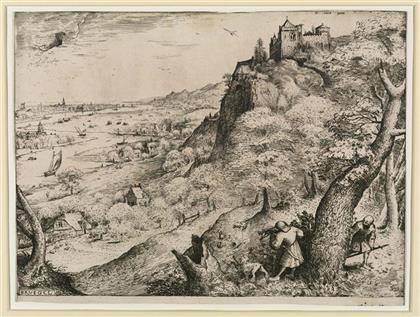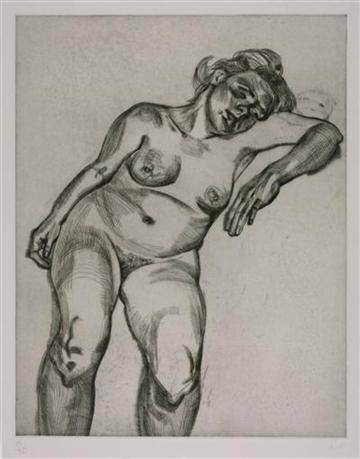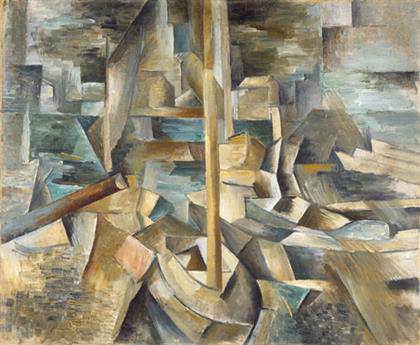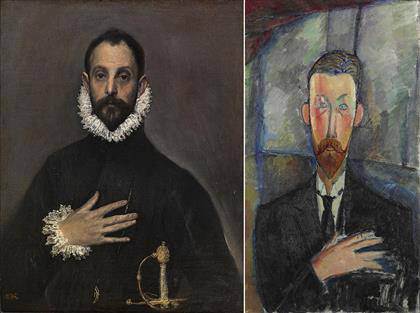
Pieter Bruegel the Elder (1525-1569)
Rabbit hunt, 1560
Etching, 22.2 x 29.1 cm
The Courtauld Gallery, London

Lucian Freud (1922-2011)
Blond Girl, 1985
Etching, 60 x 54,2 cm (plate size)
The Courtauld Gallery, London
Frank Auerbach Gift, 2012
Bruegel to Freud: Prints from The Courtauld Gallery The second Summer Showcase at the Courtauld Gallery provides visitors with an introduction to the largest but least known part of the Gallery’s outstanding collection – its holding of prints. 19 June to 21 September 2014.]]>
Source: The Courtauld Gallery
The display opens with Andrea Mantegna’s ambitious engraving of “The Flagellation of Christ” (around 1465-70), in which the Italian Renaissance artist powerfully reinvents this often depicted Passion scene. By contrast, the grand scale of a ten-part engraving after Michelangelo’s celebrated “Last Judgment” by French printmaker Nicolas Béatrizet exemplifies the ability of a print to reproduce a monumental work of art in spectacular fashion. Subjects of Christian iconography dominate 15th and 16th century printmaking but from early on were complemented by secular topics, with printmakers catering for a demand amongst collectors for new imagery. A superb example is Pieter Bruegel the Elder’s “Rabbit Hunt” (1560), the only print executed by the artist himself and one of a group of master prints bequeathed to the collection by Count Antoine Seilern in 1978. Bruegel chose the etching technique: its relative freedom and ease is more closely comparable to drawing, allowing him to render the scene with remarkable naturalism.
The possibilities of printmaking greatly expanded in subsequent centuries. Prints could record historical events such as battles or pageants, as in the exquisite etchings of Jacques Callot and Stefano della Bella. Canaletto’s views of 18th century Venice play wilful games with the city’s geography and are shown alongside the striking architectural inventions of his contemporary Piranesi. The 19th century in France saw avant-garde artists embracing printmaking, with Edouard Manet’s homage to Old Masters, Paul Gauguin’s revival of the woodcut and Henri de Toulouse-Lautrec’s brilliant adoption of the newer technique of lithography for his evocative depictions of Parisian entertainment such as his dynamic “Jockey” from Samuel Courtauld’s collection.
In the 20th century Pablo Picasso’s and Henri Matisse’s tireless experimentation helped ensure the vitality of printmaking in the art of their time. The display concludes with prints by Lucian Freud, now widely acknowledged as a modern master of the medium, and with more recent work by Chris Ofili whose prints, both figurative and abstract, have continued to reinvent printmaking in the 21st century.
The Courtauld’s prints collection is largely the result of a series of remarkable individual gifts. They include the prints presented by Samuel Courtauld alongside his collection of French Impressionist paintings and drawings, and Count Antoine Seilern’s Princes Gate bequest which brought many of the most famous individual sheets into the collection. By far the largest portion of the collection came from Sir Robert Witt, who established the Witt Library as an image bank for art historians. While the majority of the Witt prints reproduce works of art in other media, his collection also included artists’ prints of outstanding quality, including unique impressions of proof states by the 16th century artists Jacques Bellange and Johannes Stradanus.
Related content
Lucian Freud’s etchings at the Courtauld Gallery (exhibition, 2012-2013)
Follow us on:


